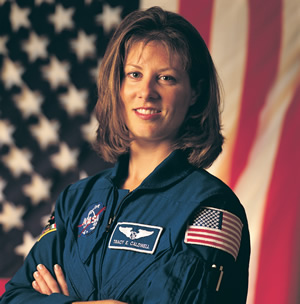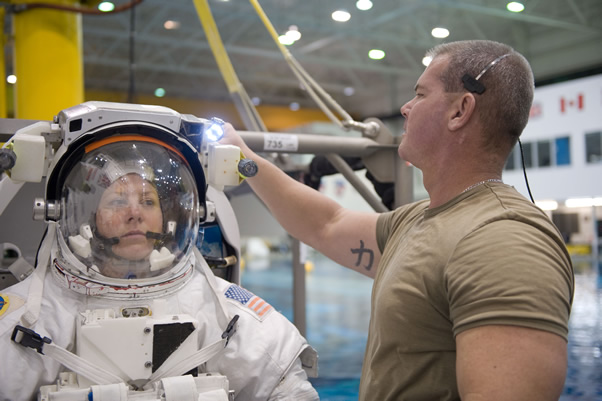Tracy Caldwell Dyson About to Launch
Alumna Readies for Second Trip Into Space and Five Months on Space Station
March 23, 2010
By Russ L. Hudson
On April 2, Tracy Caldwell Dyson (B.S. chemistry ’93) begins a two-day, 240-mile commute to her new workplace: the orbiting International Space Station, where she will spend the next five months as part of a six-person international crew from the United States, Russia and Japan.

Tracy Caldwell Dyson
Caldwell Dyson made her first trip to the space station in 2007 as a mission specialist with the seven-member crew of NASA's space shuttle Endeavour. Her inaugural space flight of 12 days, 18 hours, launched from and returned to the Kennedy Space Center in Florida. On this new trip, she will not return until September and will have experienced upwards of 2,400 sunrises and traveled more than 60 million miles.
This time, she — and two cosmonauts — blasts off from Kazakhstan in a capsule atop a Russian Soyuz rocket to become part of ISS Expedition 23. Because of the international crew, ground control and the crew will speak a mixture of English and Russian during all communications.
During this flight, Caldwell Dyson and her crew members will be living and working on the space station, dependent on the systems built and operated by the 18 participating nations of the ISS Partnership — and each other.
Caldwell Dyson's expertise as a chemist, electrician and mechanic will come in handy during this tour. In the isolation of space, crewmembers must fix anything that goes wrong, and doctor each other when there are mishaps. A vehicle arrives every other week ferrying supplies, replacement crew or more parts for the station. If an automatic docking system fails, ISS crew must instantly override and use a joystick to guide the vehicle into the dock. To maintain their readiness, the crew will conduct frequent drills: a collision with the ISS could mean catastrophe.
Drills are a daily necessity for everyone on board — procedures for depressurization, medical emergencies, manual docking of vehicles, fire suppression, equipment use, toxic spills, leaks and emergency evacuation each require a separate set of practiced responses. Crew members must respond reflexively when emergencies arise. So drllls are a daily constant, although each member gets occasional days off, a small amount of free time nearly every day and light duty in the their final two weeks.
During her tour of duty, Caldwell Dyson will assist with the installation of a cargo carrier, a multipurpose experimental support structure and three additional modules, delivered by three shuttle flights crewed by astronauts from America, Russia, Japan, Italy, Canada and England. She will be helping to finish a construction project begun in 1998 — the same year she was accepted as a NASA astronaut candidate.
The International Space Station's transition from the first 20-foot-long Russian-built module to a habitable structure of many connected modules, built by crewmembers from the U.S., Russia, Belgium, Canada, France, Germany, Netherlands and Japan, is nearly complete. It is now longer than a football field, with a habitable area of 12,000 cubic feet divided up in a string of living and working modules with nodes for storage, electrical-routing centers, small labs and vehicle docks. The ISS depends upon eight huge rectangular arrays of solar panels to generate electricity.
The ISS has been inhabited since 2000 — a decade of humans continuously living and working in space. As on previous expeditions, in addition to space walks and their specific responsibilities, Caldwell Dyson and her fellow crew members will be kept busy doing chores. As mundane as it sounds, even on a space station, common areas need to be cleaned, surfaces decontaminated with disinfectant, air ducts vacuumed, filters cleaned, water purity checks conducted, air leaks found, computers rebooted and air circulation fans checked. At home, a forgotten chore is a minor inconvenience. On the space station, it can mean life or death.
In addition to chores, drills or science, Caldwell Dyson and the other crew members must complete two exercise sessions a day — for a total of up to three hours — to keep muscle, bone and circulatory systems from atrophying.
In September, Caldwell Dyson and her fellow cosmonauts will climb back into the capsule on which they arrived, release the restraints that allow springs to push it slowly away from the ISS and toward Earth 240 miles below. A video of a soyuz capsule's return from space is available.
As it approaches the atmosphere, the capsule will initiate a prolonged burn to slow the descent. The capsule separates from the service module, then rotates, turning its blunt, heat-shielded end toward Earth. With its descent slowed, the capsule will deploy parachutes. A meter from the ground, a final rocket blast brings the capsule almost to a halt as it touches down on the grassy Kazakhstan plains, mission accomplished.


